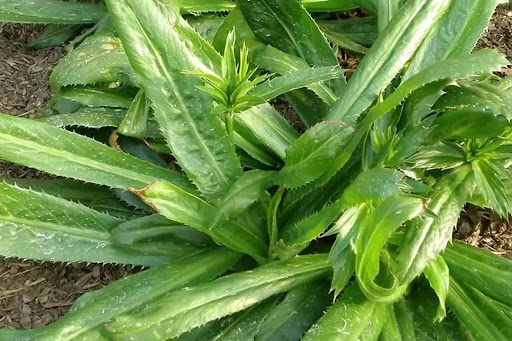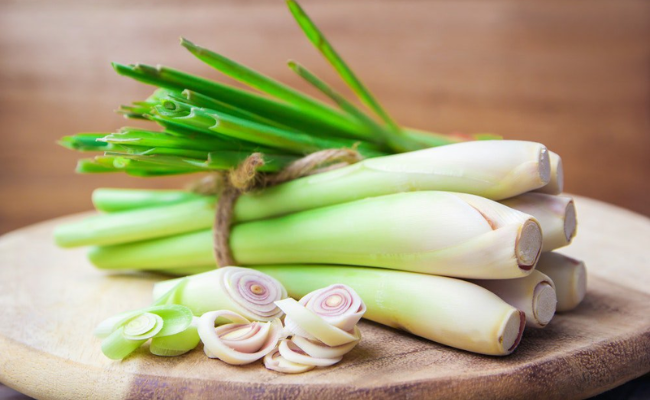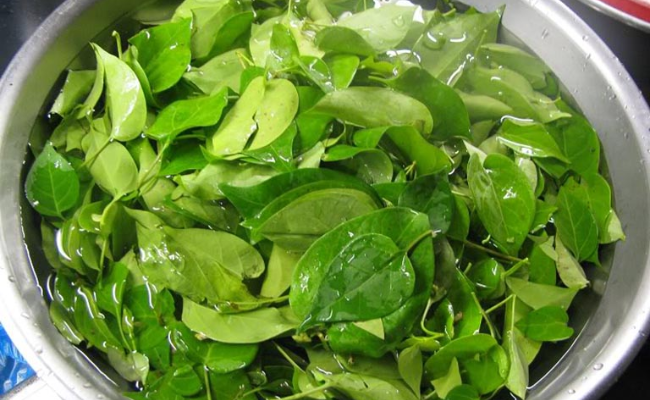Vietnamese cuisine is famously diverse, due to not only the difference in cooking techniques across regions and seasonal ingredients but also the addition of various herbs. Vietnamese people prefer adding numerous herbs to their dishes, either cooked or raw. For most dishes, Vietnamese herbs are a game changer thanks to the strong aroma and standout taste. In this article, we will introduce to you 15 of the most widely used Vietnamese herbs.
1. Coriander Or Cilantro – Rau Mùi/ Ngò

Coriander (or cilantro) is also called ‘parsley’ in Western countries. This herb is so prevalent in Vietnam as it can combine with many dishes and is easy to grow. Coriander is delicate, the leaves are thin, lacey, and clustered in three or four. It has a strong fragrance and a fresh, citrus flavour with a spicy finish.
Coriander can be served with fresh spring roll (gỏi cuốn), grilled pork banh mi (bánh mì thịt nướng), or bún chả.
2. Culantro Or Sawtooth Herb – Mùi/ Ngò Gai

Culantro is another coriander-style herb with its own distinct look and appearance. Its leaves are sharply-serrated and similar to a saw blade. That’s why culantro is also called sawtooth coriander. The flavor resembles that of coriander but is stronger. Like many Vietnamese herbs, culantro is usually added during the cooking of a dish or it can be added at the end.
You can easily find culantro served with phở or soups. Besides, other dishes served with culantro are sour soup with fish (canh cá) or rare beef in lime juice salad (bò tái chanh).
3. Vietnamese Coriander – Rau Răm

Vietnamese coriander thrives in wet areas. It has long, thin, and pointy leaves. The stems are usually dark violet. It is outstandingly aromatic and tastes somewhat like mint, but a little bit bitter and spicier.
People always eat Vietnamese coriander raw, most commonly paired with baluts and shellfish dishes, such as grilled oysters (hàu nướng), and sea snails (ốc biển). Besides, it is also enjoyed alongside sweet and sour chicken salad (gỏi gà bóp chua ngọt) or fermented pork (nem chua).
4. Rice Paddy Herb – Ngổ Ôm

Rice paddy herbs are year-round crops. They are small and short, with light green, small, and oval-shaped leaves. The smell and taste are a cross between those of cumin and lime leaves. This herb’s essential oil contains antibacterial and anti-oxidise substances, which make it a both flavourful and nutritional herb.
Rice paddy herb is an indispensable ingredient of sour soup (canh chua), where it is cooked well with other veggies and Vietnamese herbs. It is also served raw or blanched with raw veggies (rau sống), rare beef in lime juice salad (bò tái chanh), and intestine porridge (cháo lòng).
5. Piper Lolot – Lá Lốt

Similar to some Vietnamese herbs, piper lolots grow well in moist places and in warm weather. You can easily recognize it from its heart-shaped and slightly sleeky leaves. It has a unique aroma and mildly peppery taste. Besides being a cooking ingredient, piper lolots are used in medicine to reduce high blood pressure and indigestion.
People eat piper lolot raw as a wrap of boiled squids. Another popular and well-loved family dish with piper lolot is fried ground pork rolled in piper lolot (chả lá lốt).
6. Pennywort – Rau Má
This herb develops in soggy areas, such as valleys or river banks in tropical countries. Its leaves resemble pennies or duck’s feet with green colour. When eaten raw, pennywort tastes fresh and a bit grassy, and a little bitter when it’s cooked.

Vietnamese people usually boil green or dried pennywort and drink the boiling water as a daily drink. At many drink shops, this herb is also made into smoothies at an affordable price. Pennywort also appears in savoury dishes such as beef stir-fried with pennywort (bò xào rau má), pennywort salad (gỏi rau má), shrimp and pennywort soup (canh rau má tôm tươi).
7. Lemongrass – Sả

Lemongrass consists of tall stalks and leaves that develop in bushy clusters. Each stalk is slender, straight, and long with a small, bulbous base similar to the bottom of the green onion. Young lemongrass gives off a sweet, moderately tropical citrus fragrance. The mature one has a brighter, lemon-like aroma and comes with a more fibrous, chewy, and even stringy texture.
Lemongrass is often chopped and used in dishes like grilled pork (thịt nướng), pork stir-fried with lemongrass and chilies (thịt xào sả ớt), stir-fried chicken (gà rang) and many more.
8. Dill – Thì Là
Indian people have cumin in many of their recipes, while Vietnamese people prefer adding its leaves – called dill, in their seafood dishes. Unlike the Vietnamese herbs above, dill (the leaves) is small and needle-like. It releases an aromatic smell and leaves a sweet flavour.

Dill is perfect for seafood, especially fish. You can easily find dill in seafood hotpot (lẩu hải sản), Vietnamese grilled fish dish (Cha Cá Lá Vọng – a Hanoi delicacy), stew fish (cá kho), and many more.
9. Spearmint – Húng Lủi

Spearmint is medium-sized with oval-shaped and curly leaves. It gives off a minty smell and also has a minty and slightly sweet flavour. Spearmint is usually eaten raw, with other Vietnamese herbs as a side dish.
It is paired with boiled pork (thịt heo luộc), savoury rolled cake (bánh cuốn), or fresh spring rolls (gỏi cuốn).
10. Spicy Mint – Húng Cây

Like spearmint, peppermint is also medium in size. The leaves are oval-shaped without being curly. This Vietnamese herb has a minty aroma and spicy flavour with a cooling sensation.
People in Vietnam prefer pairing this herb with beef rice noodles (bún bò), phở, and boiled pork (thịt heo luộc).
11. Thai Basil – Húng Quế

This Vietnamese herb is far from resembling the Italian basil that Western people use to add flavour to their tomato sauce. Thai Basil is different, both in appearance and taste. The leaves are narrow, pointy, and serrated slightly, growing out from purple stems. It smells a bit like anise and licorice and offers a bold flavour with spicy-sweet notes of anise and black licorice as well.
Thai basil is a perfect accompaniment to chicken pho (phở gà), baby clams with basil appetiser (hến xào lá húng), and sizzling savoury crepes (bánh xèo).
12. Vietnamese Balm – Kinh Giới

Unlike some of the Vietnamese herbs above, Vietnamese balm grows in mountainous areas, and forests, where it’s brightly sunny. The leaves are green, oval-shaped with serrated edges. Its aroma is intense and is a cross between that of mint and lemon. When tasting, you’ll recognize a slightly bitter flavour.
Vietnamese balm is usually served alongside other Vietnamese herbs in dishes like bún chả, sizzling savoury crepes (bánh xèo), and crab noodle soup (bún riêu).
13. Fish Mint Or Heart Leaf – Diếp Cá

Similar to piper lolot, fish mint leaves are heart-shaped and slightly sleeky, but at a smaller size. It tastes sour and smells rather fishy, which is somewhat unpleasant and unappealing for many people on their first try.
Fish mint is usually made into smoothies in the summer to cool the body. Besides, it also appears in many Vietnamese salads (gỏi), alongside other Vietnamese herbs.
14. Vietnamese Perilla – Tía Tô

Perilla is easy to recognize among other Vietnamese herbs due to the distinct violet and green colour of the leaves. It offers a strong musky fragrance and a subtle earthy taste.
With its taste and aroma, this herb is perfect when paired with bún chả, crab noodle soup (bún riêu), grilled pork (thịt nướng), and more.
15. Sour-Soup Creeper – Lá Giang

This plant grows along river banks and channels in the central and southern regions of Vietnam. The leaves are spade-shade and green on the front. It tastes distinctly sour, light, and somewhat like tamarind.
Sour-soup creeper is the main ingredient for sour-soup creeper hotpot (lẩu lá giang), sour soups (canh chua), and goes well with beef and chicken.
Final Thoughts
Vietnamese herbs are attached to Vietnamese people’s daily lives: they appear in both their small breakfast and lavish feasts. So if you have a chance to visit this S-shaped country and try its best dishes, don’t forget to pair them with the right herbs!
>> Read more: Vietnamese Fruit: 14 Strangest And Most Delicious Types



